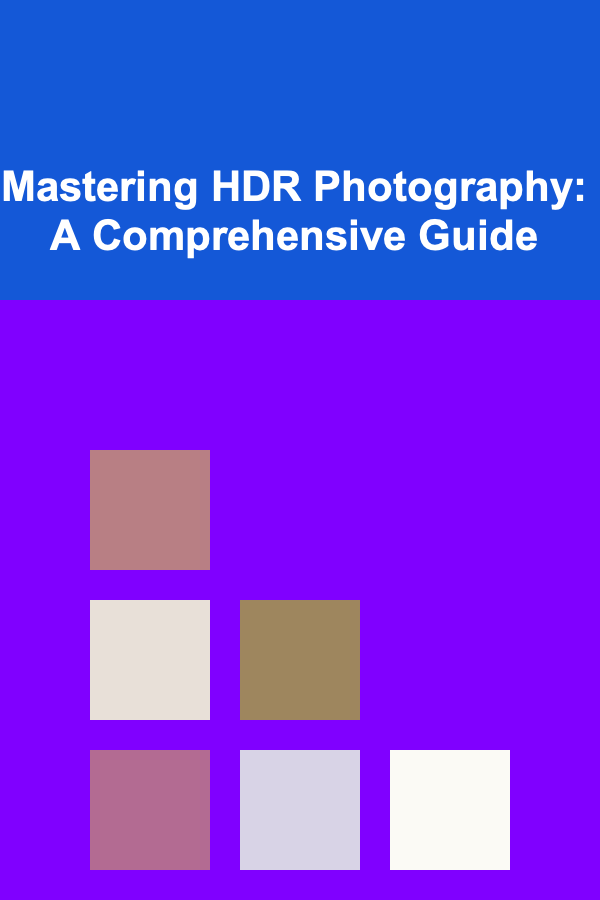
How To Choose the Right Lens for Every Shot
ebook include PDF & Audio bundle (Micro Guide)
$12.99$8.99
Limited Time Offer! Order within the next:

Choosing the right lens for every shot is one of the most important decisions a photographer can make. Whether you are shooting portraits, landscapes, events, or wildlife, the lens you choose will directly impact the mood, depth, and clarity of your photographs. With a variety of lenses available, each offering unique features and perspectives, understanding how to choose the right one can elevate your photography.
In this article, we will delve into the various types of camera lenses, their characteristics, and how to make the best choice based on the subject, lighting, and overall composition of the shot. We'll explore focal lengths, apertures, lens types, and other factors that play a role in lens selection. By the end of this guide, you'll have the knowledge to confidently choose the perfect lens for every situation.
Understanding Lens Basics
Before diving into specific types of lenses, it's essential to understand the basic terminology and concepts that influence lens performance. These include:
- Focal Length: The distance between the lens' optical center and the camera's sensor, usually measured in millimeters (mm). Focal length affects the field of view and magnification.
- Aperture (f-stop): The opening in the lens that controls how much light enters the camera. It also impacts depth of field.
- Field of View: The extent of the scene captured by the lens, which is determined by the focal length.
- Depth of Field: The range of distance in a shot that appears sharp, which can be influenced by the aperture, focal length, and distance from the subject.
- Image Stabilization: A technology that helps reduce the blur caused by small movements when shooting handheld.
By understanding these basic principles, you can better comprehend how each lens affects the final image.
Types of Lenses and When to Use Them
Lenses come in various types, each suited for different photography needs. Let's take a closer look at the most common lens types and when to use them.
2.1. Prime Lenses
A prime lens is a fixed focal length lens, meaning it cannot zoom in or out. While this might seem limiting at first, prime lenses offer some distinct advantages that can be valuable in many situations.
Advantages:
- Sharpness: Prime lenses typically offer better image quality and sharper details compared to zoom lenses.
- Larger Apertures: Prime lenses often come with wider maximum apertures (like f/1.8 or f/1.4), making them ideal for low-light conditions and creating a shallow depth of field for background blur (bokeh).
- Lightweight and Compact: Because they don't have the complex zoom mechanisms, prime lenses are generally smaller and lighter than zoom lenses.
Best for:
- Portraits: A 50mm f/1.8 or 85mm f/1.4 lens is perfect for creating beautifully blurred backgrounds and sharp, detailed portraits.
- Low-light Photography: The wide apertures of prime lenses let in more light, making them ideal for shooting indoors or at night.
- Street and Documentary Photography: The compact size of prime lenses makes them easy to carry around, and their fast aperture allows you to capture sharp images in low light.
2.2. Zoom Lenses
A zoom lens allows you to adjust the focal length, giving you the flexibility to change the composition of your shot without physically moving. Zoom lenses cover a wide range of focal lengths, making them versatile for many types of photography.
Advantages:
- Convenience: The ability to zoom in and out without changing lenses allows you to quickly adapt to different shooting situations.
- Versatility: Zoom lenses are ideal for capturing subjects that are difficult to approach or when you need to cover a variety of focal lengths without switching lenses.
Best for:
- Event Photography: Weddings, concerts, and other events often require you to capture both wide-angle and telephoto shots. A zoom lens like a 24-70mm f/2.8 can handle most situations.
- Wildlife Photography: A 100-400mm zoom lens is great for photographing animals that are distant or difficult to approach.
- Travel Photography: A zoom lens can be a great all-in-one solution when you're traveling and don't want to carry multiple lenses.
2.3. Wide-Angle Lenses
A wide-angle lens has a shorter focal length, typically in the range of 10mm to 35mm, and captures a wider field of view. These lenses allow you to fit more into the frame, making them ideal for certain types of photography.
Advantages:
- Expansive Field of View: Wide-angle lenses are perfect for capturing landscapes, architecture, and group shots, where you need to include more elements in the frame.
- Creative Composition: The wide field of view can create interesting perspectives, such as exaggerating the size of objects in the foreground.
Best for:
- Landscape Photography: A 16-35mm lens allows you to capture sweeping vistas and detailed landscapes.
- Architectural Photography: Wide-angle lenses are great for photographing large buildings or interiors, where you need to show the full scale of the subject.
- Astrophotography: A fast wide-angle lens (such as a 14mm f/2.8) allows you to capture the night sky with a wide field of view.
2.4. Telephoto Lenses
A telephoto lens has a long focal length, typically ranging from 70mm to 600mm or more. Telephoto lenses allow you to capture distant subjects, bringing them closer and isolating them from the background.
Advantages:
- Magnification: Telephoto lenses can magnify distant subjects, making them perfect for wildlife, sports, and portrait photography.
- Shallow Depth of Field: Telephoto lenses often produce a beautiful background blur (bokeh), which is ideal for isolating your subject.
Best for:
- Wildlife Photography: A 200-400mm telephoto lens lets you capture wildlife from a safe distance without disturbing the animals.
- Sports Photography: Long lenses like a 70-200mm f/2.8 are commonly used in sports photography to capture fast-moving subjects from a distance.
- Portraits: A 85mm or 135mm lens can produce flattering compression, creating a beautiful subject-background separation.
2.5. Macro Lenses
A macro lens is designed for extreme close-up photography, allowing you to capture tiny subjects like insects, flowers, or textures with incredible detail.
Advantages:
- Extreme Detail: Macro lenses can focus on subjects at very close distances, offering high magnification and sharpness.
- Great for Textures and Small Subjects: Whether it's capturing the intricate details of a flower petal or the texture of a rock, macro lenses provide unparalleled detail.
Best for:
- Nature Photography: Macro lenses are essential for photographing insects, plants, and small wildlife.
- Product Photography: When shooting small objects, such as jewelry or intricate products, macro lenses allow you to capture fine details.
2.6. Fish-Eye Lenses
A fish-eye lens is an ultra-wide-angle lens that captures a 180-degree field of view, creating a distinctive, curved perspective. Fish-eye lenses are often used for creative and experimental photography.
Advantages:
- Unique Perspective: Fish-eye lenses create dramatic, exaggerated perspectives, bending straight lines and producing a circular image.
- Creative Effects: They are often used for creative or artistic purposes to add a sense of fun and surprise to photos.
Best for:
- Creative Photography: Fish-eye lenses are great for capturing unusual angles, such as curving cityscapes or dynamic sports shots.
- Architectural Photography: They can be used to create striking images of buildings, especially in tight spaces where a wide field of view is necessary.
Key Factors to Consider When Choosing a Lens
Choosing the right lens is not just about picking a focal length; several other factors should influence your decision.
3.1. Lighting Conditions
Consider the lighting conditions in which you'll be shooting. Lenses with larger apertures (such as f/1.4 or f/2.8) are ideal for low-light situations, as they allow more light to reach the sensor. This makes them particularly useful for indoor photography, evening shoots, or shooting in dimly lit environments.
3.2. Depth of Field Control
If you want to isolate your subject with a shallow depth of field, opt for lenses with larger maximum apertures. For example, a lens with an f/1.4 or f/1.8 aperture will create a beautifully blurred background, making the subject stand out. Conversely, a smaller aperture like f/8 or f/11 will provide more depth of field, which is beneficial for landscape or macro photography.
3.3. Size and Weight
Lenses vary in size and weight, and this can significantly impact your comfort, especially during long shoots or when traveling. A prime lens tends to be smaller and lighter than a zoom lens, making it easier to carry around for extended periods. On the other hand, zoom lenses, while heavier, can replace multiple prime lenses, reducing the need to carry several pieces of gear.
3.4. Budget
Lenses can be a significant investment, with prices varying widely depending on the type and brand. While high-end lenses like those with fast apertures (f/1.4 or f/2.8) can be expensive, there are often budget-friendly alternatives. Third-party brands like Sigma, Tamron, and Tokina offer high-quality lenses at a lower price point compared to camera manufacturers' own lenses.
Conclusion
Choosing the right lens is a crucial aspect of photography, and the ideal lens for any shot depends on several factors, including the subject, lighting, and desired outcome. Understanding the unique characteristics of different lenses, such as their focal lengths, apertures, and uses, will allow you to select the right lens for every scenario.
Ultimately, the right lens is one that helps you realize your creative vision while offering the technical capabilities to achieve the best results. With practice and experience, you will learn to select the lens that best suits each situation, transforming your photography into an even more powerful and expressive medium.

10 Ways to Earn Passive Income with Deep Learning
Read More
How to Use Labels and Tags for Efficient Organization
Read More
How to Use VR for Space Exploration Training
Read More
How to Understand the Role of Inflammation in Disease
Read More
Mastering HDR Photography: A Comprehensive Guide
Read More
10 Tips for Perfectly Pressed Wildflowers
Read MoreOther Products

10 Ways to Earn Passive Income with Deep Learning
Read More
How to Use Labels and Tags for Efficient Organization
Read More
How to Use VR for Space Exploration Training
Read More
How to Understand the Role of Inflammation in Disease
Read More
Mastering HDR Photography: A Comprehensive Guide
Read More